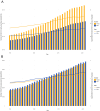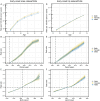Global, regional, and national burden of early-onset OA attributable to high BMI: 1990-2021 estimates and 2036 projections from the global burden of disease study
- PMID: 40668785
- PMCID: PMC12266449
- DOI: 10.1371/journal.pone.0328414
Global, regional, and national burden of early-onset OA attributable to high BMI: 1990-2021 estimates and 2036 projections from the global burden of disease study
Abstract
Objective: High BMI is a critical risk factor for early-onset OA (diagnosed before age 55). This study aimed to analyze global trends in the age-standardized disability-adjusted life years rates (ASDR) attributable to high BMI from 1990 to 2021.
Methods: Data from the Global Burden of Disease 2021 (GBD 2021) study were analyzed to assess early-onset OA attributable to high BMI across 204 countries, 21 GBD regions, and 5 Socio-Demographic Index (SDI) tiers. Temporal trends in ASDR were quantified using the estimated annual percentage change (EAPC) and Joinpoint regression. Age-period-cohort models and decomposition analysis identified drivers of burden, while inequality was assessed using the Slope Index of Inequality (SII) and Concentration Index (CI). ARIMA models projected trends to 2036.
Results: The disease burden of early-onset OA attributable to high BMI increased significantly between 1990 and 2021. The DALYs for early-onset knee and hip OA rose by 203.01% and 170.12%, respectively, with average annual percentage changes (AAPC) of 1.39% and 1.40%. The age-period-cohort analysis indicated that DALYs risk increased with age and period, and later birth cohorts experienced a higher burden of early-onset OA attributable to high BMI. Decomposition analysis revealed that population growth was the primary driver of the rising disease burden. There were significant absolute and relative inequalities in the burden of early-onset OA attributable to high BMI, as measured by the SDI. Countries with higher SDI bore a greater burden. The SII demonstrated that the ASDR gap between countries with the highest and lowest SDI widened steadily from 1990 to 2021. Predictive analysis suggested that the burden of early-onset OA attributable to high BMI will continue to increase over the next 15 years.
Conclusion: From 1990 to 2021, the global burden of early-onset OA attributable to high BMI showed a consistent upward trend, with significant inequalities across countries. The disease burden is projected to grow further in the future.
Copyright: © 2025 Zhang et al. This is an open access article distributed under the terms of the Creative Commons Attribution License, which permits unrestricted use, distribution, and reproduction in any medium, provided the original author and source are credited.
Conflict of interest statement
The authors have declared that no competing interests exist.
Figures









Similar articles
-
The global burden and epidemiological trends of gout, particularly cases attributable to high Body Mass Index (BMI) in adolescents and young adults (aged 15-39 years): a secondary analysis from global burden of disease study 2021.Clin Rheumatol. 2025 Aug;44(8):3295-3308. doi: 10.1007/s10067-025-07494-w. Epub 2025 Jun 18. Clin Rheumatol. 2025. PMID: 40533689
-
Global, regional, and national burden and projections to 2050 of occupational carcinogen-attributable nasopharyngeal and laryngeal cancer: a comprehensive analysis from the GBD 2021 study.Front Public Health. 2025 Jul 4;13:1615378. doi: 10.3389/fpubh.2025.1615378. eCollection 2025. Front Public Health. 2025. PMID: 40687131 Free PMC article.
-
The global burden of aortic aneurysm attributable to hypertension from 1990 to 2021: Current trends and projections for 2050.PLoS One. 2025 Jul 18;20(7):e0327830. doi: 10.1371/journal.pone.0327830. eCollection 2025. PLoS One. 2025. PMID: 40679972 Free PMC article.
-
Global burden and risk factors of musculoskeletal disorders among adolescents and young adults in 204 countries and territories, 1990-2019.Autoimmun Rev. 2023 Aug;22(8):103361. doi: 10.1016/j.autrev.2023.103361. Epub 2023 May 23. Autoimmun Rev. 2023. PMID: 37230312 Review.
-
Global burden and risk factors of childhood cardiovascular disease (1990-2021).Front Public Health. 2025 Jul 3;13:1543044. doi: 10.3389/fpubh.2025.1543044. eCollection 2025. Front Public Health. 2025. PMID: 40678645 Free PMC article. Review.
References
MeSH terms
LinkOut - more resources
Full Text Sources
Miscellaneous

